Indian Chief 1947
With Ian Falloon
Although the original Indian company folded as far back as 1953, few makes of motorcycles still command such a dedicated following. Indian began in 1901 when George Hendee and Oscar Hedstrom launched Indian Motocycles (without the “r”) in Springfield, Massachusetts.
The company was staggeringly successful and by 1911 had won the Isle of Man TT with a 1000 cc V-twin. By 1913 sales grew to 32,000 and Indian was the world’s largest motorcycle manufacturer. Unfortunately World War I and the following economic downturn hurt Indian and in an endeavour to create new market in 1920 they released of the 600 cc V-twin Scout. A highly advanced design, it was immediately successful.
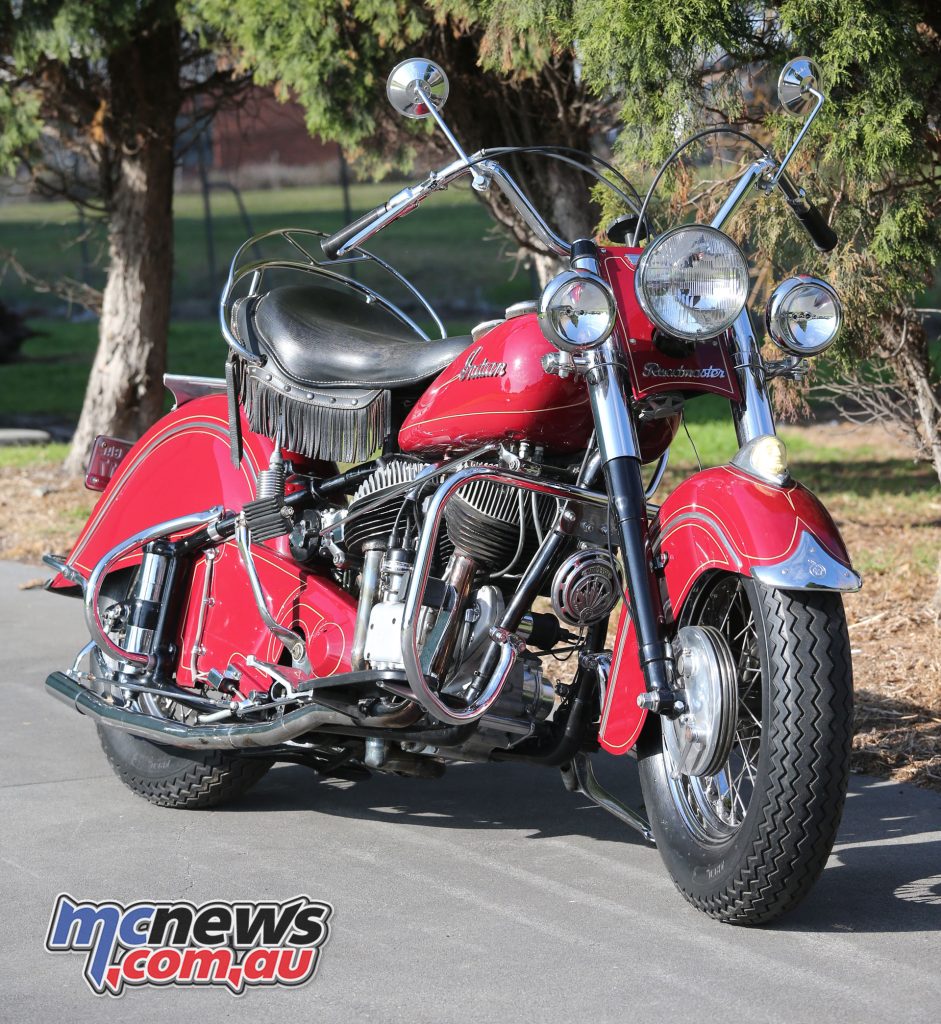
While renowned for many models, the backbone of the Indian legend was the Chief, one of the most elegant American motorcycles ever built, and unashamedly designed for the open road and straight line running.
The Chief offered neither technological supremacy nor outright performance, and despite the competition from Harley-Davidson’s continually developed big twin throughout its life, the Indian Chief remained a formidable open road machine until its demise. The Chief was a triumph of design over development and the final 1953 model was remarkably similar to the original Chief of 1922.
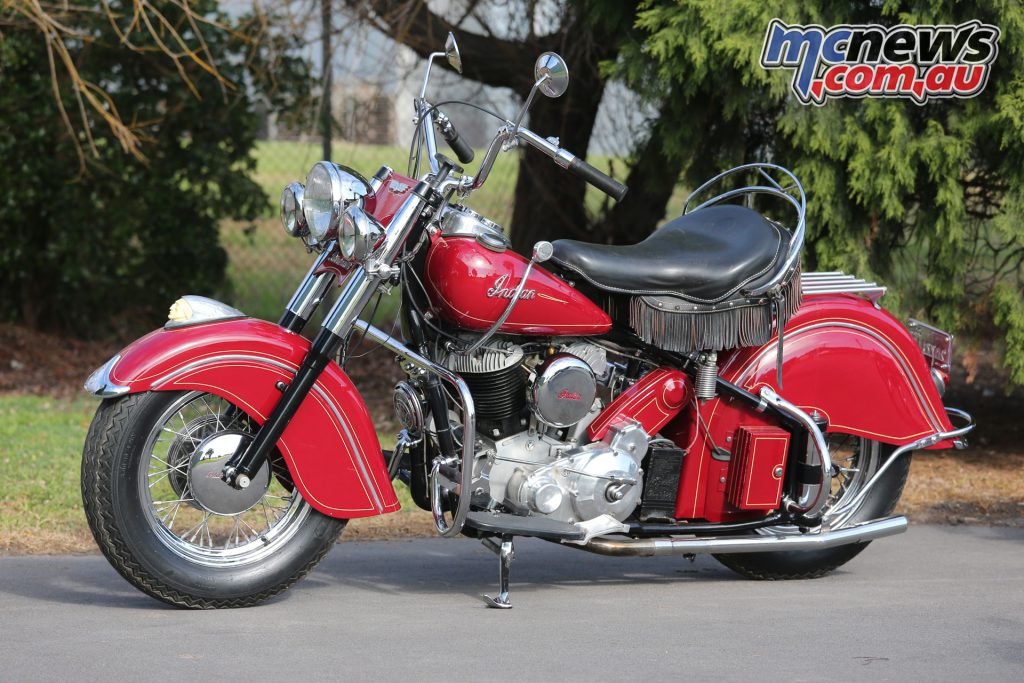
Initially 998 cc, the side-valve 42-degree V-twin Chief evolved out of the 600 cc Scout and shared many of its features. These included two camshafts operating the side-valves and a helical gear primary drive. The engine and gearbox were bolted together, creating a more rigid structure than the comparable Harley-Davidson.
Although the Chief didn’t produce much power (about 20 horsepower), the performance was typical for the 1920s and to counter the new Harley 74-cubic-inch big twin, Indian created the 1206 cc Big Chief for 1923.
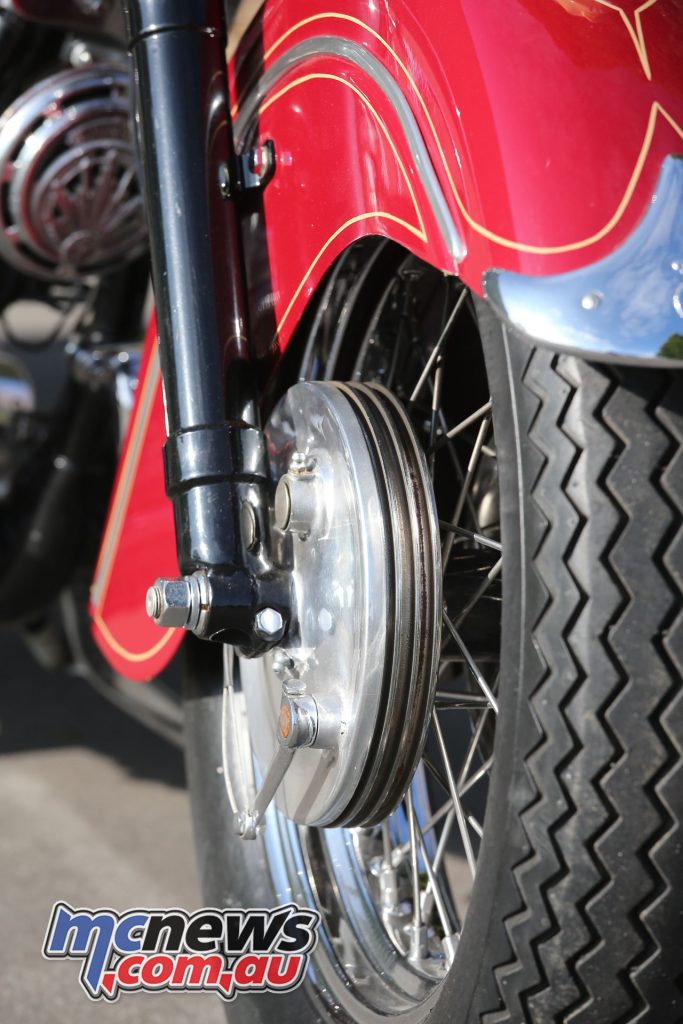
During the 1920s the company initially neglected the Chief’s development, and by the end of the decade were more intent on developing the newly acquired four-cylinder. The Chief struggled against the Harley-Davidson until 1931 when the new president of the company, E. Paul du Pont, initiated a policy of continual improvement.
In response to claims of inadequate performance the Chief’s engine was updated for smoother running and completely re-styled for 1932. Dry sump lubrication was introduced in 1933 and chain primary drive in 1934 but when Harley released their overhead valve Knucklehead in 1936 it looked like the end for the side-valve Indian. Indian was used to holding US top speed and long distance records but they lost these to Harley in 1937.
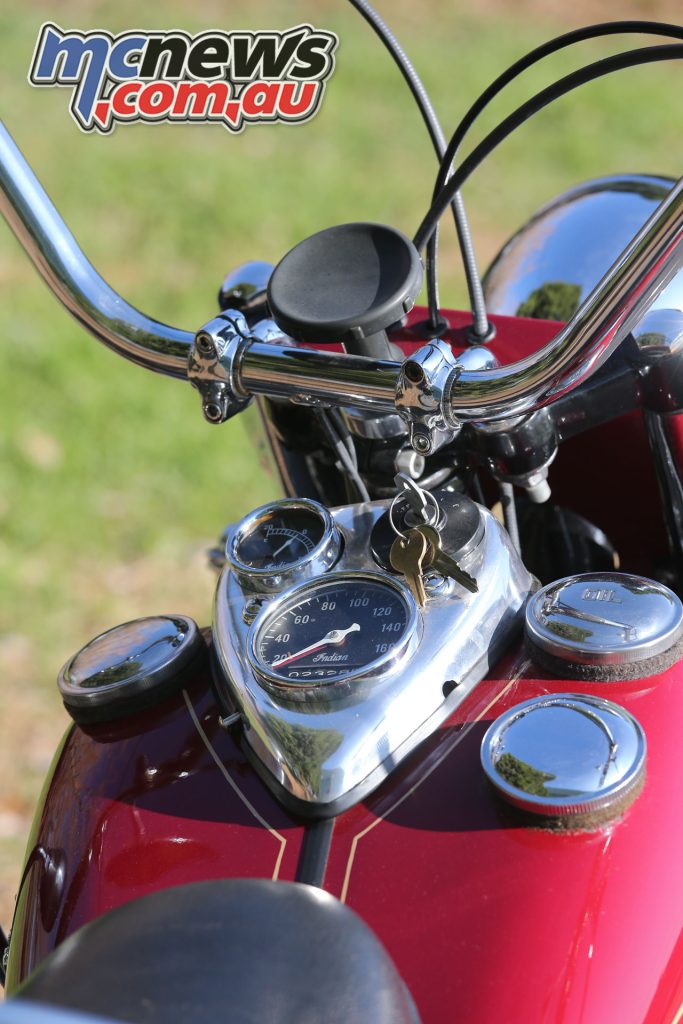
After struggling through the end of the 1930s and war years, Indian had new owners in 1946, and with the company in financial crisis the Chief finally became the range leader. But new manager Ralph Rogers was determined to produce a range of lightweight motorcycles and once again development of the Chief stagnated.
But for a new double spring girder front fork with a hydraulic shock absorber and 5.00 x 16-inch tyres, the Chief was little changed from earlier versions. For 1947 the Chief received some styling revisions, most noticeable this being the first year of the Indian head in the front mudguard running light. Even then many traditional Indian features were retained, such as the foot clutch and hand-operated three-speed gearshift.
Also new for 1947 were new chrome-plated INDIAN fuel tank emblems, these replacing the earlier Indian-head type. These would feature through until the end of production in 1953. This year also saw three accessory packages offered, all available in Jet-Black, sparkling Seafoam Blue or brilliant Indian Red enamel.
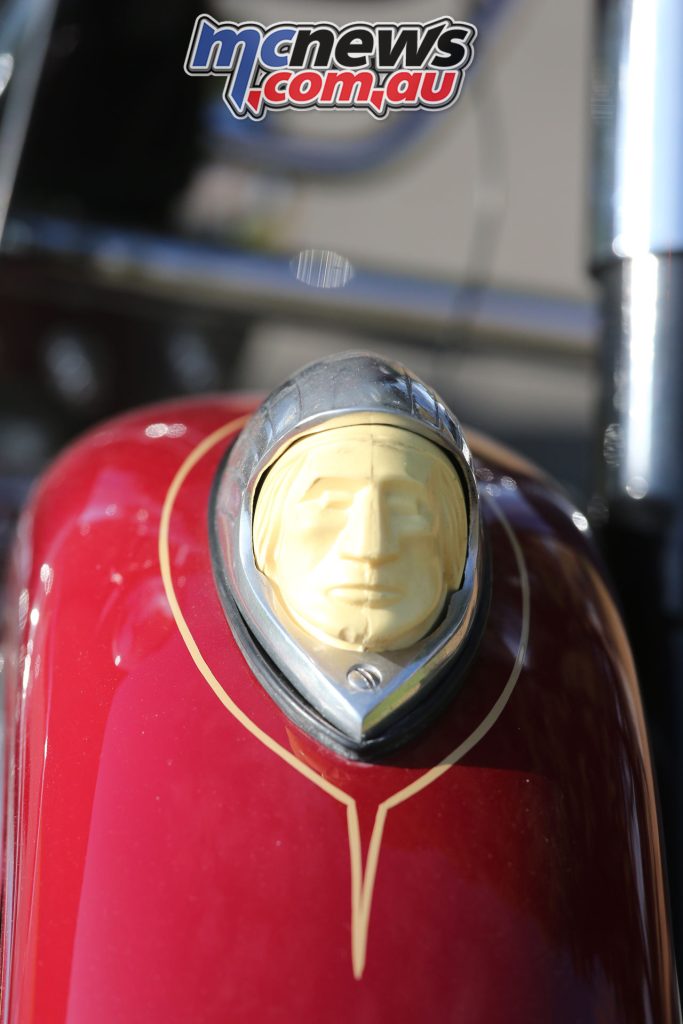
The cheapest trim level was the Clubman, which still came with plenty of chrome. It had chrome fuel tank caps, front brake lever, ignition cable tube, exhaust system, horn face, rear spring shrouds and gearshift lever, a shiny alloy trim running either side of the front fender, a chrome air cleaner cover, and chromed rear bumper. Costs were kept down with painted handlebars, wheel rims and crash bars.
The next rung up the ladder was the Sportsman, which had all the chromed parts of the Clubman, but the handlebars, crash bars and headlamp were also chrome plated and the seat an Indian “Deluxe.”
The full touring package was the Roadmaster with all the chrome and equipment of the Sportsman, but added a Sport windshield, chromed twin spotlights, saddlebags with chrome rivets, a chromed handlebar cross-tube and the new Indian “Chum-Me” seat with adjustable springing so “you could take your best friend along, too.”
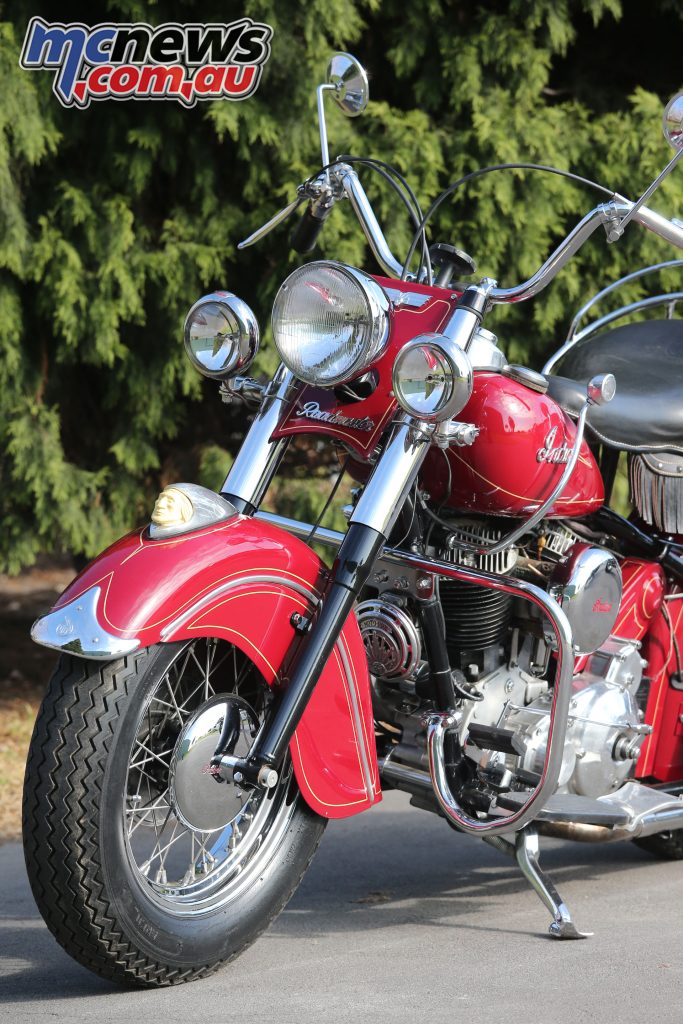
The model shown here is a Sportsman, with later telescopic fork and buddy seat. In the late 1940s Indian managed to sell the side-valve to potential buyers by comparing their engine to the side-valve high-end General Motors Cadillac and Harley’s overhead valve Knucklehead to the GM base model Chevrolet.
With all resources going into the development of a dubious range of modular lightweight singles and twins the Chief was dropped for 1949 but the venerable side-valve twin failed to die. The spectacular failure of the 220 cc Arrow single and its vertical twin Scout stable mate saw the Chief re-emerge for 1950.
Now with a larger 80 cubic inch (1300 cc) engine and a telescopic front fork this was Indian’s final attempt to stay alive. Now the largest capacity American twin, it demonstrated Indian’s capacity to somehow survive for over thirty years by updating an obsolete design, succeeding despite of the trend towards overhead-valves.
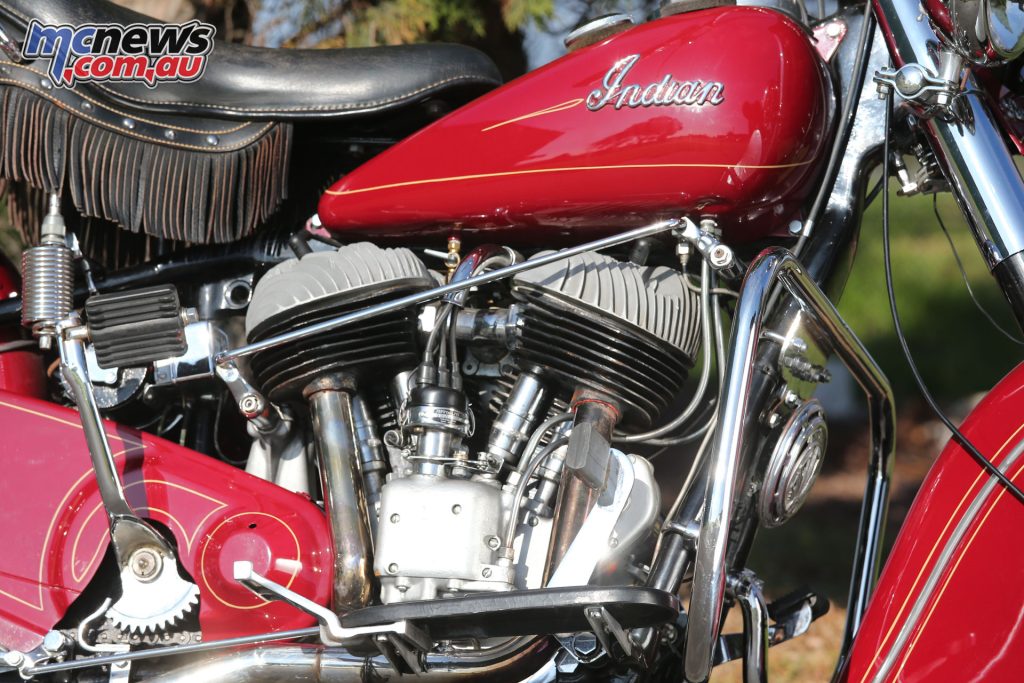
Only a handful of these final Chiefs were constructed and economic problems finally saw the demise of Indian motorcycle production at the end of 1953. Although often playing second fiddle to others in the line-up it is the Chief that has become the archetypal Indian. Its appeal as a large capacity mile eating motorcycle is much the same now as it was seventy-five years ago.
1947 Indian Chief Specifications
| 1947 Indian Chief Specifications | |
| Engine type | 42-degree V-twin, four-stroke side-valve |
| Bore and Stroke | 83 x 113 mm |
| Displacement | 1212 cc |
| Fuel system | Carburettor Linkert |
| Power | 40 hp @ 4700 rpm |
| Transmission | Chain (final drive) |
| Front suspension | Telescopic fork |
| Rear suspension | Plunger with coil springs |
| Front brake | Expanding drum |
| Rear brake | Expanding drum |
| Wheelbase | 1540 mm |
| Weight | 262 kg |
| Top speed | 160 km/h (approx..) |
Check out more historical motorcycle articles by Ian Falloon here (link).























